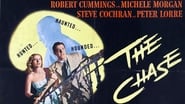arfdawg-1
The Plot.Returning a lost wallet gains unemployed veteran Chuck Scott a job as chauffeur to Eddie Roman, a seeming gangster whose enemies have a way of meeting violent ends. The job proves nerve-wracking, and soon Chuck finds himself pledged to help Eddie's lovely, fearful, prisoner-wife Lorna to escape. The result leaves Chuck caught like a rat in a trap, vainly seeking a way out through dark streets. But the real chase begins when the strange plot virtually starts all over again.This seems to be a very intriguing film however my experience was marred by a really bad print that rendered the sound all garbled in spots.Even so, i got into the plot.Not sure why Peter Lorre is billed down the pike when he's pretty important to the film.In all, it's a pretty good semi-film noir.
dougdoepke
A troubled ex-serviceman gets a job with a crime boss and his disturbed wife.A 'find' for me and perhaps for other fans of noir. The 80-minutes are a perfect blend of dark visuals and surreal story. Frankly, when I think noir, I don't think Bob Cummings, an excellent light comedy actor, but hardly a figure of depth. But here, he essays the role of the troubled vet in subtle and persuasive ways. The nightclub scenes in Havana are particularly revealing, as the chaotic gaiety swirls around Scott (Cummings) and his spacey lover Lorna (Morgan)—a perfect metaphor for their circumstance.A number of touches make this a memorable film. Casting Lorre as Gino was a coup, since his quietly devilish imp casts a background shadow over the proceedings. That's significant because Cochran, the alleged crime boss, comes across as a rather charming fellow even if he's behind dark deeds. Then there's that scene in the wine cellar, unlike any I've seen, and shrewdly abbreviated to catch the imagination. Also, catch Lorna's cameo framing through the porthole with shadows rising and falling over her face, as her nature itself migrates between light and dark. Add to the mix a speeding locomotive as the hand of fate, and a weirdly backseat driver that really is a backseat driver, and you've got an appropriately noirish race against time. And, of course, mustn't leave out the final scene so perfectly calibrated to end the film on a provocatively surreal note. The movie's full of such imaginative twists and turns as penned by two of the best in the business, Woolrich and Yordan. I'm not sure why the movie's generally overlooked in the noir canon, perhaps because of Bob Cummings and his lightweight reputation, plus the lack of a true spider woman. Nonetheless, it's a provocative little gem, and one that prompts rare second thoughts long after the screen has gone dark.
chaos-rampant
In just the first scene the noir schmuck, an ex-GI back from the war, is wistfully looking at a man frying bacon behind a shopwindow, looks down, where —lo— in a sardonic twist of noir fate, he discovers a wallet full of money. Being a straight-up guy, he shows up at the mobster's place in Miami to return it, where he's promptly hired as a driver, falls for the unhappy wife, and elopes with her to Havana, the place of desire.It's a dreamy setup worthy of the most profound noir, but the movie outright fails — the acting is stiff, the romance is forced, the pace is lethargic, the camera is uninteresting. We simply have second- grade talent doing poverty row work for a quick pay.But even botched Woolrich is something, and this one's just so bizarre. The narrator, our GI schmuck, suffers such intense anxiety (possibly related to the war, as often in noir). Midway through the narration breaks down and re-arranges the world. This is preceded by his very own death following a very murky chase through Havana, another deeply noirish twist. Anyway, it turns out that he was never in Havana, though he has the two tickets in his pocket.We have obvious hallucination but the weirdest thing is as follows: 'when' the hallucination starts is undefinable and the ensuing 'real' story picks up from some point in it and culminates in another previously hallucinated moment in Havana. It's strange, because nothing is really done with it. But as clear explication of noir—as with Woolrich's Fear in the Night, almost too clear for my taste—this is straight to the point. Noir Meter: 3/4
Cristi_Ciopron
The cast might be the main reason for seeing this expired thriller; Lorre, Mrs. Morgan and Cochran make quite a combo. She is the damsel in distress; Lorre recycles his persona, Cochran is truly mischievous, and many scenes are interesting—e.g., Scotty's first meeting with the mysterious Roman.I enjoyed, moderately, most of this Cochran vehicle—until it took its Woolrich twist. And this twist spoiled the fun so severely that I barely can abstain from spoiling that nerdy twist. I simply do not approve at all of these Woolrich devices. Why did they believe such things work—in the flicks, at least? Without the Woolrich twist, the movie was pretty interesting; after the twist, it's a mess. But it was clumsily narrated all the way.I have to admit not being very thrilled by the standard Woolrich crap—and I hop I do not spoil too much if I say that this outing is pretty standard Woolrich crap. The cast is nice—the gorgeous Mrs. Morgan, Cochran as a bad guy, and Lorre in a not unpleasant performance. The melodrama suddenly takes an unexpected twist, something very Woolrichian, and it becomes utter crap; but—even way before that, the plot was quite elliptic and as if leaving out things. This way of narrating abruptly and by leaps looks awkward and clumsy in such hands—even if used deliberately (which it's not so obvious this was the case).In a word, the plot gets muddled suddenly, at about ¾ of the story, which reminded me of the stupid twists the kids give their stories in order to boost the suspense or something.




